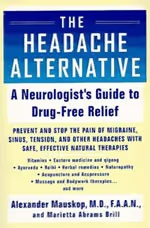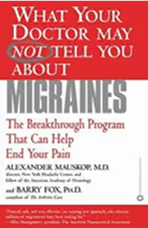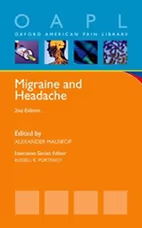Caffeine and Headaches
Caffeine is included in many over-the-counter and prescription medications. It helps relieve migraines by constricting blood vessels and by directly relieving pain. However, caffeine is also a major cause of headaches, especially in the difficult-to-treat chronic migraines. People consuming large amounts of caffeine develop headaches not from caffeine, but due to caffeine withdrawal. This fact was confirmed by a double-blind study published in the New England Journal of Medicine. Half of the group of people, who normally did not suffer from headaches and were consuming only about 2 and 1/2 cups of coffee a day were switched to decaf. More than half of the people switched to decaf developed a headache, while the control group did not. Those people who are prone to having headaches are also much more prone to having caffeine-withdrawal headaches. The fact that caffeine causes headaches often comes as a surprise since many sufferers feel that caffeine in coffee, soda or medications actually makes them feel better. What they often don’t realize is that they are just adding fuel to the fire. Patients who start taking Excedrin or another drug find that with time they need to take more and more of the medication with less and less relief. The only way to stop headaches in these patients is by stopping caffeine.Often it is not easy to do because headaches will first get worse before they get better. A physician can prescribe medications to relieve pain during the period of caffeine withdrawal, but usually after a few days headaches improve and no medications are needed at all. If headaches persist, a preventive medication, biofeedback or Botox injections can be used. Excedrin, Fioricet and other caffeine-containing drugs sometimes can be very effective, but to avoid caffeine-induced or, so called rebound headaches not more than 15-20 tablets should be taken each month. Caffeine has many other negative effects on some people. It can heighten anxiety, cause insomnia and has been reported to promote cyst formation in ovaries and breasts. Obstetricians advise pregnant women not consume caffeine because of its possible, although not definitively proven deleterious effect on the fetus. The following article from The New York Times suggests another negative effect of caffeine on the heart, which may also occur in the brain. VITAL SIGNS Advice on Racing to a Starbucks in Denver By NICHOLAS BAKALAR Published: January 24, 2006 In a small study, researchers have found that the caffeine equivalent to two cups of coffee appears to reduce significantly the body’s ability to increase blood flow to the heart in response to exercise. The effect was especially strong when volunteers exercised while breathing air that simulated the oxygen levels at high altitudes. Eighteen regular coffee drinkers who had refrained from drinking coffee for 36 hours exercised on a stationary bicycle to establish normal levels of blood flow to the heart. Each then swallowed a 200-milligram caffeine pill. After 50 minutes of rest, enough time to allow the caffeine to attain its peak level in the blood, they performed the same exercise again. While caffeine did not affect blood flow at rest, it produced a 22 percent reduction of blood flow with exercise at 1,500 feet above sea level, and a 39 percent reduction at the equivalent of 15,000 feet of altitude. The results were reported in the Jan. 17 issue of The Journal of the American College of Cardiology. Dr. Philipp Kaufmann, the lead author on the study and a professor of cardiology at University Hospital in Zurich, said that while the risks for healthy people were minimal, those with coronary artery disease might be at considerably greater risk. He is not, however, prepared to recommend that healthy people forgo coffee before exercise. “In view of the fact that millions of people drink coffee before doing ordinary exercise and experience no health problems,” he said, “I do not think that we should expand our advice to the whole population.” But, he added, “Before doing high-level exercise, and particularly at high altitude, coronary artery disease patients should probably avoid caffeine.”
.jpg)



This “book” appears to have largely been born out of his blog from the New York Headache Center. For years, he has regularly put up information, scientific and clinical, for his headache followers. He has created this “book,” actually an e-book, which takes relevant information from his experience and knowledge of migraine. There is no need for an index and chapter references. He uses hyperlinks, embedded in the e-book, to connect to material online, which he puts in context for the reader. This works very well as one hyperlink may go to an original paper or publication or a resource site.
He links to major medical journals including headache journals and his own publications, when helpful, as well as nonmedical literature and other sites. This format allows the e-book to be updated from time to time, which is easy to do with this approach.
The book has a very interesting introduction and deals with evidence-based medicine and its role in migraine therapy. When he begins the section on 150+ treatments, he starts with a very interesting comment. Many of the treatment ideas that I describe in this book are not just off-label (that is, not approved by the FDA) but may appear to be off-the-wall. It is refreshing to hear such intellectual honesty from a practicing neurologist.
There is a great section on supplements and finding someone to help with your migraine, such as coach, a partner, or a sympathetic friend. A diagnostic discussion follows and is most helpful, as proper diagnosis directs treatment, as are the detailed sections on triggers including environment, food, exercise, physical therapies, and sleep. Herbal therapies are covered as is neuromodulation and injections/blocks among others.
In the sections on drugs, he deals with acute therapies and the modern use of triptans and gepants, and a ditan. Preventive therapies start with monoclonal calcitonin gene-related peptide antibodies, tricyclic medications, and many other preventive therapies including beta blockers, anti-seizure drugs, nonsteroidal anti-inflammatory drugs, and botulinum injections. From acupuncture to Feldenkrais methods, he covers the contemporary plethora of migraine “treatments” as he sees it in practice.
He ranks all medications on a 1 to 10 scale regarding his own subjective opinions of the utility of each treatment. He indicates that no treatment gets 10 as a score and any receiving a score of 1 were not rated. He also lists his favorite migraine therapies separately. He includes a lot of data links here, from single case reports to full-scale randomized clinical trials, and detailed reviews. His clinical acumen shines through the volume and one gets the impression that this is a very personal view at times, not always backed by evidence, as there may not be any, but by experience, practice and pragmatism. He carefully notes the general things to be careful of in taking some treatments and warns if there are serious concerns. Nonetheless, he indicates clearly that the advice of a medical professional should be sought before trying the therapies mentioned.
Diagnosing secondary headache that can mimic migraine or vice versa is a useful section but does not go into depth about the disorders/diseases mentioned, as this is not the intention of the book. Special circumstances are given sections including menstrual migraine, pregnancy, resistant/refractory headache, aura and headache, and many others.
The author is a senior, highly experienced neurologist and has a high degree of interest in migraine and other headache disorders. He has a sense of curiosity about the brain and migraine and that comes through to the reader of this small volume. I count 23 endorsements, including the excellent foreward of the book from a wide range of well-known people, which includes two prior editors of this journal. He is well liked and highly respected by his colleagues.
In many ways, this book does what online databases on diseases cannot do most times. He tells the reader what he knows and how to use that knowledge. He directs the novice and experts to the right literature and takes the reader on a personal journey through the field of migraine treatments. He tells people, “…keep seeking relief, not to give up on or blame yourself for the pain you experience from migraine.”
There is a printed version of the book; however, the e-book is ideal for the intended purpose. I would recommend it the first instance. It is available via a commercial site and inexpensive.
I would recommend this book to anyone who has migraine or cares for people with migraine and wants a broad and sometimes detailed overview of the treatments. Available in the e-book format, it represents a lot of work for one person, but his passion, occasional humor, and historical perspectives are evident in this work. You don’t have to agree or accept everything the author says to enjoy and benefit from this “book,” and I know he would want people to be critical and skeptical where warranted. However, you will find more than you would usually need to know from this banquet of 150 ways to help your migraines! Enjoy, I did very much. Read it through once and save as reference.
Alexander Mauskop, Director of the New York Headache Center, and Marietta Abrams Brill, a freelance medical writer, have written principally for headache sufferers in North America. They answer questions like “is Rolfing covered by medical insurance?”, and include an excellent resource section in the back. of the book which lists American organizations for the various therapies. But they provide enough background information on both headache and alternative treatments to make their book interesting to readers from other countries, too. In covering most of the more common alternative therapies~like herbs, acupuncture, massage, Ayuverda and Eastern medicine, and qigong-they aim to inform rather than judge, cite research evidence where it exists, and point to potential dangers as well as benefits.
Each of the 10 chapters is introduced with a pithy quote: “Divine is the work to subdue pain” (Hippocrates) heads the first chapter. After general background on pain theories and headache diagnosis, common alternative approaches are covered in turn and there is, of course, oodles of advice on diet and nutrition. A helpful glossary guides readers through words that conventional doctors are familiar with, like Scotoma, and those with which we aren’t, like Qi, Vatta, and Pitta. To round off, a comprehensive resource section and selected bibliography give useful directions to readers wanting more information about specific therapies.
Like all good guides, this one follows a logical structure and so it is relatively simple to go quickly to the information you want to find. It is easy to read. All in all, it is a guide which headache sufferers looking for good information on alternative therapies can be thankful for.
